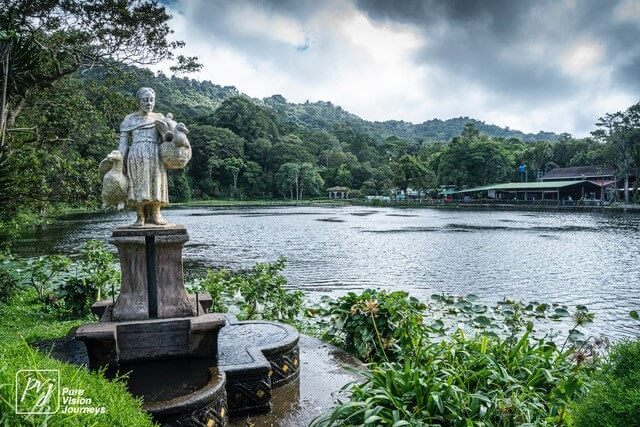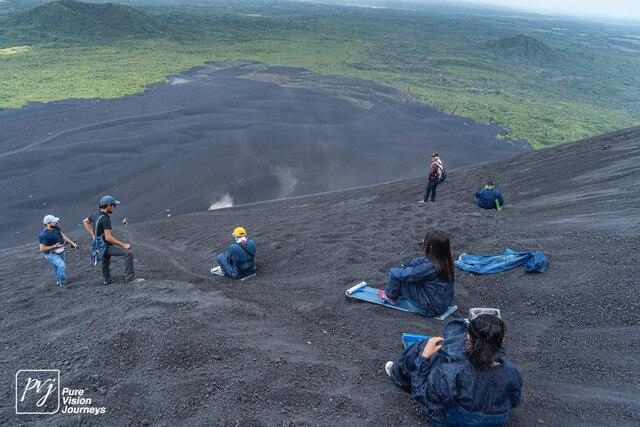It was September 2019, I was flying to Nicaragua, the largest country in the Central America but it is less known to tourists. However, it has awakened to the strategic importance of tourism and aims to show its hidden beauties to the world.
 We began our explorations in the north of Managua and arrived in Selva Negra Ecolodge, 12 kilometres from the town of Matagalpa. We only stayed one night at Hotel Selva Negra. My wooden cottage with a deck, was set in a nature reserve environment within a forest, surrounded by a farm and coffee plantation. There were two lakes, one of them in front of the restaurant and the reception area. The Selva Negra restaurant offers both local and international cuisine. The privately-run estate belongs to a German family, descendants of settlers from the 19th century.
We began our explorations in the north of Managua and arrived in Selva Negra Ecolodge, 12 kilometres from the town of Matagalpa. We only stayed one night at Hotel Selva Negra. My wooden cottage with a deck, was set in a nature reserve environment within a forest, surrounded by a farm and coffee plantation. There were two lakes, one of them in front of the restaurant and the reception area. The Selva Negra restaurant offers both local and international cuisine. The privately-run estate belongs to a German family, descendants of settlers from the 19th century.
The sound of birds woke me up the next day. After breakfast, we set out on a bus tour to Selva Negra, over 6 square kilometres of woodland landscapes. The Selva Negra Ecolodge guide explained the history and ambitious sustainability aspirations of the Selva Negra. He showed us the coffee plantation fields, farmlands and a large silo to see the machinery for processing the coffee. We had lunch at the Selva Negra’s restaurant which offered the best of local cuisine. My choice was fresh sea bass served with chips, rice and salad.
 In the afternoon, we headed towards the historical city of Leon which was a three-hour drive. Leon is a historic city, 90 kilometres northwest of Managua and 18 kilometres away from the coast of the Pacific Ocean. The city was founded by Spanish conquerors in 1524, but was partly destroyed by earthquakes and volcanic eruptions and had to be abandoned in the early 17th century. A new Leon was established in 1610, the capital of Nicaragua for a time before Managua become the permanent capital in 1852.
In the afternoon, we headed towards the historical city of Leon which was a three-hour drive. Leon is a historic city, 90 kilometres northwest of Managua and 18 kilometres away from the coast of the Pacific Ocean. The city was founded by Spanish conquerors in 1524, but was partly destroyed by earthquakes and volcanic eruptions and had to be abandoned in the early 17th century. A new Leon was established in 1610, the capital of Nicaragua for a time before Managua become the permanent capital in 1852.
We arrived in Leon on the National Day in Nicaragua. The day is celebrated because of the independence of the Central American provinces from Spanish rule in 1821. There were parades and marching bands by school boys and girls along the streets of Leon, cheered by proud spectators, waving Nicaraguan flags.
 We were invited to climb up to the Cathedral’s roof. We took a very narrow internal staircase to reach the first roof of the church and there were more outdoor steps to go further up to the top roof. Leon Cathedral is the Basilica of the Assumption of the Blessed Virgin Mary and completed in 1814. It’s located in the Plaza Parque Central Juan José Quezada. Our guide, explained that the original church was a wooden structure built in 1610 but was burned down by a pirate called William Dampier. This Cathedral, the largest church in Central America is a UNESCO World Heritage Site and the most important landmark of Leon.
We were invited to climb up to the Cathedral’s roof. We took a very narrow internal staircase to reach the first roof of the church and there were more outdoor steps to go further up to the top roof. Leon Cathedral is the Basilica of the Assumption of the Blessed Virgin Mary and completed in 1814. It’s located in the Plaza Parque Central Juan José Quezada. Our guide, explained that the original church was a wooden structure built in 1610 but was burned down by a pirate called William Dampier. This Cathedral, the largest church in Central America is a UNESCO World Heritage Site and the most important landmark of Leon.
 I stayed overnight at La Perla Hotel in the city of León, close to the city’s main square. This boutique hotel with 15 spacious airconditioned rooms on two floors around a beautiful courtyard, with statues of two lions in the middle, was originally designed by Spanish settlers.
I stayed overnight at La Perla Hotel in the city of León, close to the city’s main square. This boutique hotel with 15 spacious airconditioned rooms on two floors around a beautiful courtyard, with statues of two lions in the middle, was originally designed by Spanish settlers.
In the morning, I decided to join a small group to climb the Cerro Negro Volcano Mountain. It is only 26 kilometres from Leon. You climb about a mile to reach the crater and then sandboard down the volcano.
 It was very tough for me to ascend the steep mountain walking over the rocky black surface. It took me over an hour to reach the top. All my efforts were rewarded once I was at the top and had a 360-degree panoramic view of the contrasting landscapes of the black and grey mountain and the surrounding green forest.
It was very tough for me to ascend the steep mountain walking over the rocky black surface. It took me over an hour to reach the top. All my efforts were rewarded once I was at the top and had a 360-degree panoramic view of the contrasting landscapes of the black and grey mountain and the surrounding green forest.
It was time to sand board to the base of this mountain. I wore a blue jumpsuit and goggles to protect my eyes from dust. I sat on a simple wooden sandboard and with a push started my journey down. It was a thrilling ride, frequently controlling my speed and balance by using my legs. The surface was smooth and with a speed of up to 60 kilometres, you are down in minutes.
 Our guide told me that Cerro Negro is the youngest Volcano in Nicaragua and erupts every 20 years. The last time it erupted was in 1999. So, you never know when it will erupt again. It was certainly a memorable experience like no other.
Our guide told me that Cerro Negro is the youngest Volcano in Nicaragua and erupts every 20 years. The last time it erupted was in 1999. So, you never know when it will erupt again. It was certainly a memorable experience like no other.
We returned to Managua in the evening to fly back home the next day. My trip to Nicaragua was a short glimpse of this fascinating country. I’d love to return to Nicaragua and discover more of its history, nature, culture and adventurous activities.
More information
For more information about Nicaragua, visit www.visitnicaragua.us.
To see more of Reza’s images of Nicaragua, go to www.amirinia.com/nicaragua.
Images and story © Mohammad Reza Amirinia











